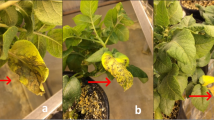Abstract
Out of five F1 plants of the crossSorghum controversum (2n=40)×S.almum (2n=40) one was found to be desynaptic. It is suggested that this desynapsis, which is of the “medium-strong” class, may be due to a spontaneous mutation. Several meiotic abnormalities have been recorded and possible explanations are suggested. The plant was found to be highly pollen sterile and did not set seed on selfing. However, when pollinated with normal pollen from one of its parents, 1 to 5 seeds per panicle were obtained.
The possible utility of this material for physiological studies on crossing over and chiasma formation has been indicated.
Similar content being viewed by others
References
Beadle, G. W. (1930). Genetical and Cytological studies of Mendelian asynapsis inZea mays.Mem. Cornell Agric. Exp. Sta. 129, 1–23.
Beadle, G. W. &B. McClintock (1928). A genic disturbance of meiosis inZea mays L.Science 68, 433.
Beadle, J. O. &M. S. Brown (1942). Asynaptic Gossypium plants and their polyploids. J. Agric. Res.65: 421–427.
Bergner, A. D., J. L. Cartledge &A. F. Blakeslee (1934). Chromosome behaviour due to a gene which prevents metaphase pairing inDatura.Cytologia 6: 19–37.
Böök, J. A. (1945). Cytological studies inTriton.Hereditas 31, 177–220.
Celarier, R. P. (1955). Desynapsis inTradescantia.Cytologia 20, 69–83.
Celarier, R. P. &K. L. Mehra (1959). Desynapsis in theAndropoganeae.Phyton 12, 131–138.
Clausen, R. E. (1931). Inheritance inNicotiana tabacum XI.Amer. Nat. 65, 317–331.
Darlington, C. D. (1937). Recent Advances in Cytology. 2nd Ed. J. A. Churchill Ltd., London.
Eklundh Ehrenberg, C. (1949). Studies on asynapsis in the elm,Ulmus glabra Huds.Hereditas 35, 1–26.
Håkansson, A. (1943). Meiosis in a nullisomic and in an asyndeticGodetia whitneyi.Hereditas 29, 179–190.
Huskins, C. L. &E. M. Hearne (1933). Meiosis in asynaptic oats and wheat.J. Royal Micros. Soc. 53, 109 (Biol. Abstr. 1935, Entry 17605).
Johnson, H. (1944). Meiotic aberrations and sterility inAlopecurus myosuroides Huds.Hereditas 30, 469–566.
Kita, F., M. L. Magoon &D. C. Cooper (1959). Simple smear techniques for the study of chromosomes ofMelilotus.Phyton. 12, 35–38.
Krishnaswamy, N. &K. Meenakshi (1957). Abnormal meiosis in grainSorghums — desynapsis.Cytologia 22, 250–262.
Levan, A. (1940). The cytology ofAllium amplectens and the occurrence in nature of its asynapsis.Hereditas 26, 359–394.
Li, H. W., W. K. Pao &C. L. Li (1945) Desynapsis in common wheat.Amer. J. Bot. 32, 92–101.
Magoon, M. L., M. S. Ramanna &K. G. Shambulingappa (1961). Desynapsis and spontaneous chromosome breakage inSorghum purpureosericeum.Indian J. Genet. 21, 87–97.
Magoon, M. L., S. Ramanujam &D. C. Cooper (1962). Cytogenetical studies in relation to the origin and differentiation of species in the genusSolanum L.Caryologia 15, 151–252.
Morgan, D. T. (1956). Asynapsis and plasmodial microsporocytes in maize following X-irradiation of the pollen.J. Heredity 47, 269–274.
Pal, B. P. &S. Ramanujam (1940). Asynapsis in chilli (Capsicum annuum L.).Curr. Sci. 9, 126–128.
Prakken, R. (1943). Studies of asynapsis in rye.Hereditas 29, 475–495.
Ramaer, H. (1935). Cytology ofHevea.Genetica 17, 193–236.
Ramanujam, S. &N. Parthasarathy (1935). Asynaptic mutant in Rice (Oryza sativa, L.).Proc. Ind. Acad. Sci. 2B: 80.
Richardson, M. M. (1935). Meiosis in Crepis II. Failure of pairing inCrepis capillaris.J. Genet. 31, 119–143.
Ross, J. G., M. E. Sanders &C. J. Franzke (1960). Asynapsis inSorghum.Hereditas 46, 570–580.
Swaminathan, M. S., M. L. Magoon &K. L. Mehra (1954). A simple propionocarmine PMC smear method for plants with small chromosomes.Indian J. Genet. 14, 87–88.
Swaminathan, M. S. &B. R. Murty (1959). Aspects of asynapsis in plants. I. Random and non-random chromosome association.Genetics 44, 1271–1280.
Author information
Authors and Affiliations
Rights and permissions
About this article
Cite this article
Sadasivaiah, R.S., Magoon, M.L. Studies of desynapsis inSorghum . Genetica 36, 307–314 (1965). https://doi.org/10.1007/BF01557163
Received:
Issue Date:
DOI: https://doi.org/10.1007/BF01557163




